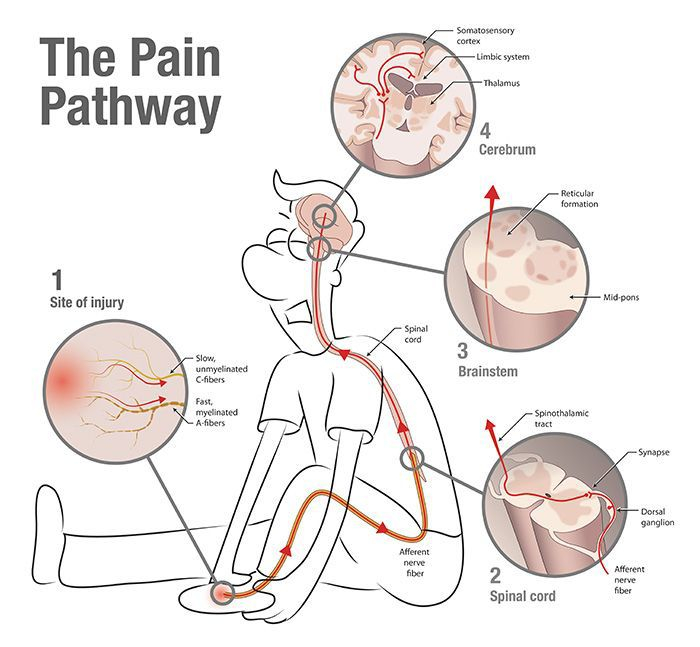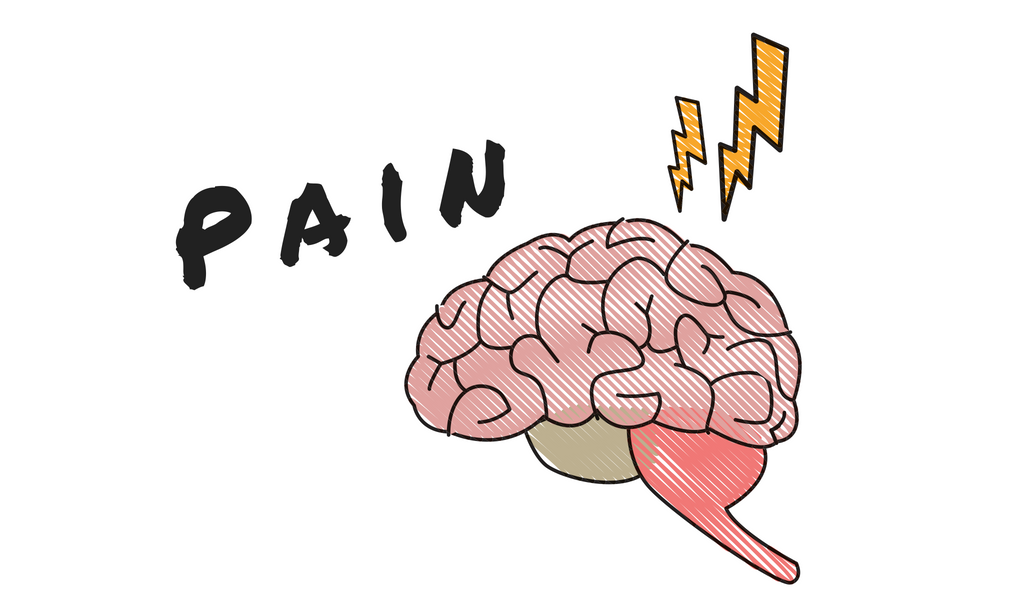“My brain hurts” is something that people sometimes say when they refer to having headaches. But does your brain really hurt? How come that brain surgeries can be performed with the patient being fully conscious? Shouldn’t a brain pace maker like it is used in the treatment of parkinson’s hurt? Can the brain even feel pain? In the following I will adress this question which was asked by @xgojirax on instagram!
First things first: What is pain?
To understand if the brain can feel pain, we first have to understand what pain is and how it works. Pain is so to say the warning message sent to ther brain when tissue is being damaged or damage is to be expected. Therefore, a life without pain would lead to us walking around not noticing that we’ve got injured and making it even worse because we still walk on that broken foot. Our brain uses our senses like vision or smell to receive information about the outer world. If something doesn’t smell nice, the olfactory receptors tell the brain to ‘better not eat it. Likewise, pain gives the brain information about our inner world. To do so, we need so called nociceptors (‘pain-receptors’), open nerve-endings with a looong nerve fiber reaching all the way to the spinal cord, where it has a synaptic ending. Together with other nerve fibers they form the peripheral nervous system, sending inner and outer state updates to the spinal cord and brain (central nervous system).
Important for the sensation of touch are the A-ß-fibers, which can send their messages at a speed of up to 270 km/h (75m/s) to the brain, because of their good myelination. The A-δ-fibers are responsible for sharp pain less myelinated, and therefore slower (126 km/h). Slowest are the unmyelinatedC-fibers for dull pain, itch and temperature, firing at a top speed of 7,2 km/h.
The pain pathway
- tissue damage (for example from a cut in the toe) is sensed by nociceptors, which send a message through fast and slow fibers to the dorsal root ganglion, a group of neurons in the spinal cord
- there, the signal splits and enters the reflex pathway to lift the foot and prevent from further damage and in addition travels through the brainstem to the brain
- in the brain, the information is sorted by the thalamus and handed to different areas, like the limbic system (emotional content), the insula (origin of the pain), frontal cortex (decision-making, thinking) and the somatosensory cortex
You might have noticed, that pain from the same kind of injury doesn’t always feel the same. Sometimes you don’t even notice your injury for a while. There’s actually thought to be a mechanism that decides whether the message coming from the peripheral nervous system is even allowed to enter the brain or supposed to be amplified. This theory is called gate control theory (Melzack & Wall, 1965). Especially in tricky situations the brain is busy making sure that you survive – pain wouldn’t help that a bit, right?
Considering that and the fact, that we don’t feel pain while we’re unconscious (e.g. during surgery), the sensation of pain emerges in the brain.

So, are there nociceptors in the brain?
Nope. That’s why we don’t feel pain during brain surgery. In 1930 Harold Wolff sticked a needle into the brain of a conscious patient during surgery and didn’t get a pain response. Tissue damage within the brain can not be perceived as pain.
But what is a headache then?
There’s a second part to Harold Wolffs surgery. After he irritated the brain, he touched the ‘skin’of the brain, the dura mater, with a brush. When he did that, the patient reported a dull pain. Indeed, the dura mater contains a lot of nociceptors, which is why it is thought to be responsible for headaches. But also the pia mater, the arachnoid layer, the scalp, muscles of the neck, skin, and blood vessels are thought to play a role. So in fact, headaches are the sensation of a disturbance (e.g. an aseptic inflammation) of pain sensitive structures around the brain. Since most of them are very close to the brain, we often have the impression that the pain is coming from the brain.
In a nutshell, the brain itself does not feel pain when brain tissue is being damaged. Still, the sensation of pain as a response to tissue damage in the head and body, emerges within the brain.
I hope that I answered your question and that you’ve enjoyed this post. If you have a question, that you want to have answered, feel free to leave it in the comments or send me a direct message on instagram.
See you soon,
\Stina
Hobson, Anthony R. and Aziz, Qasim. Central Nervous System Processing of Human Visceral Pain in Health and Disease. News in Physiological Sciences. Vol. 18, No. 3. June 2003. pp 109-114
Merck Manual Home Health Handbook. Overview of pain http://www.merckmanuals.com/home/brain_spinal_cord_and_nerve_disorders/pain/overview_of_pain.html
Merck Manual Home Health Handbook. Types of painhttp://www.merckmanuals.com/home/brain_spinal_cord_and_nerve_disorders/pain/types_of_pain.html
Physiology and pathophysiology of pain In: eTG complete. Melbourne: Therapeutic Guidelines Limited; 2011 Nov. http://online.tg.org.au/complete/
Types of pain In: eTG complete. Melbourne: Therapeutic Guidelines Limited; 2011 Nov. http://online.tg.org.au/complete/

